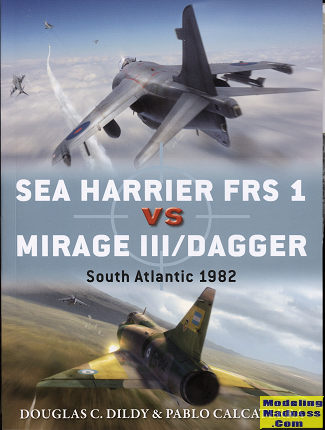 (Note that
though the Argentines call the islands the Malvinas, the current owner calls it
the Falklands and so that is how I will refer to it in this review.
(Note that
though the Argentines call the islands the Malvinas, the current owner calls it
the Falklands and so that is how I will refer to it in this review. |
Author: |
Douglas Dildy & Pablo Calcaterra |
|
Publisher/Distributor |
Osprey Publishing |
|
Price |
$18.00 MSRP |
|
Reviewer: |
|
| Notes: |
80 pages, 7¼ x 9¼ inches, softcover ISBN: 978-1-4728-1889-8 |
 (Note that
though the Argentines call the islands the Malvinas, the current owner calls it
the Falklands and so that is how I will refer to it in this review.
(Note that
though the Argentines call the islands the Malvinas, the current owner calls it
the Falklands and so that is how I will refer to it in this review.
The Falklands War was one that neither side really was prepared to fight. The Argentines had a historical claim to it but it was the British who populate the island and the islanders consider themselves British. Several referendums were put forth as to whether they want to be part of Argentina, and every one was defeated in favor of the status quo.
How this conflict came about was the British in 1981 started a large drawdown of forces in order to save money. This meant that all military presence on the Falklands (which was really rather minimal in the first place) was withdrawn. Seen as a sign of weakness, the Argentines put forth plans to retake the islands and did so.
Needless to say, this did not go down well in London. There was the usual political wrangling, but Argentina remained firm and continued a build up of military forces not only on the Falklands but also on New Georgia. The British response was to gather together a task force that consisted of their two Harrier and helo equipped carriers along with troop ships and escorts. There were a few very long range bombing missions to try to put the runway at Stanley out of commission, but these only resulted in a temporary loss of use, though they were big morale boosters.
On the Argentina side of things there were sufficient ships in the navy to go against the British task group, but the sinking of a cruiser by a British submarine caused the navy to basically stay home. This left any attacking forces up to the air force and naval air. On the air force side were Mirage III/V variants and early A-4s. The navy had A-4s and five Super Etendards, the latter of which were used later in the war and is beyond the scope of this review. The British basically had the ship-borne Sea Harrier as well as a container ship full of RAF Harriers which would be used for ground attack later.
So on one side you have supersonic interceptors with not the greatest avionics or missiles and on the other you have subsonic VSTOL aircraft with the best avionics and weapons of the time. The Mirage III versions were the interceptors and the first meeting of the two showed they were not properly equipped for air to air fighting against superior weapons. After one less than positive encounter the Mirage III was only used for high altitude escort. The Mirage V (Dagger) was a fighter bomber and not equipped with a radar. To make matters more difficult, the Falklands were at the edge of their operational range so it was get in, bomb, and get out.
Thanks to the superiority of the Sea Harrier's us produced AIM-9L Sidewinders, a goodly number of Daggers and A-4s were lost. It could have been worse, but due to the high speed of the Daggers, the subsonic speed of the Sea Harriers and the short low altitude range, the Argentine planes often outran their adversaries.
This book looks at both sides of the conflict with authors who have a particular interest in the two sides. This produces a well balanced look at how the air war of the two types progressed. Several things came out of this. The Royal Navy needed decent aerial radar coverage, having lost that when the Gannet AEW went away with the Ark Royal. Argentine low level attacks were not discovered, for the most part, until the planes were on top of the target. The Argentines realized they needed better avionics and weapons, but as if often the case with cash-strapped nations, that did not happen. Lessons were learned, fixes were made as best as possible, lives were lost and nothing really changed.
The book is superbly illustrated with great photos and art work. It is a very good read with lots of pilot stories and a good overall look at the war along with an assessment of the conflict. Very much worth picking up.
January 2018
Copyright ModelingMadness.com. All rights reserved.
For more on the complete line of Osprey books, visit www.ospreypublishing.com .
If you would like your product reviewed fairly and quickly, please contact me or see other details in the Note to Contributors.